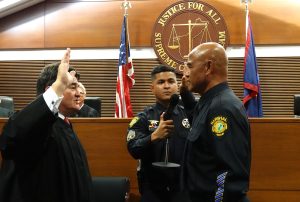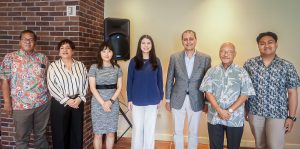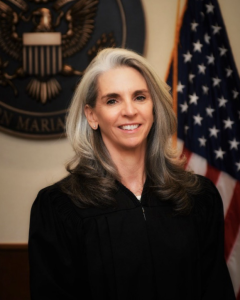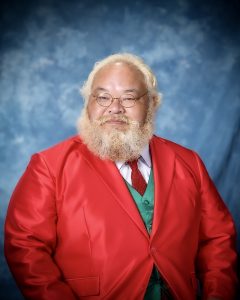PSS, private, govt sector begin 4-day Strategic Planning Institute
Key government and private sector leaders, policymakers, decision-makers and students joined yesterday the Public School System for the first-ever Strategic Planning Institute.
The institute is a four-day event that aims to “look at the core” need for the Public School System with both the government and the private sector—as “one stakeholder”—supporting high school graduates’ choice: pursue college education or career.
These industry leaders all agree that the largest source of the local workforce are graduates of PSS.
Close to about 200 participants attended yesterday’s first day. They include school administrators, educators, parent leaders, and youth leaders.
Education Commissioner Dr. Lawrence F. Camacho initiated the strategic planning institute.
Dr. Allison Leyland, chief education strategist of the Academic Development Institute and of the U.S. Department of Education’s Region 18 Comprehensive Center Network, was the overall facilitator of the four-day event.
Camacho and Special Education State director Donna M. Flores were facilitators for both the morning and afternoon panel discussions.
“The (Strategic Planning Institute) is here to help us establish and realign our goals and direction, an opportunity for us to look beyond who we are today as one community,” Camacho said.
At the outset, government and private sector leaders have already agreed “to strengthen collaboration by aligning its needs and direction” to that of the school district.
“We are glad that all of our partners are here to help us ‘re-imagine and re-structure PSS’ focus to reflect and align all the government and private sector’s needs and programs geared towards education and workforce development,” Camacho added.
“With the current structure that we have in the CNMI, we need alignment,” Career and Technical Education Program director Dr. Jessica Taylor said. We have opportunities for everyone.”
“We are here to put together into one focus the priorities that are being shared with us by each government department and the private sector; how we can incorporate that into our long-term plan. In that we hope to achieve this through Commissioner Dr. Camacho’s initiative of bringing all our stakeholders together,” said co-facilitator and SPeD State director Flores.
Data
The panelists in the morning session were Saipan Chamber director Alex Sablan, House Speaker Edmund Villagomez (Ind-Saipan), Department of Labor Employment Services director Eugene Tebuteb, Department of Labor Workforce Investment Agency director Frances Torres, Youth Congress speaker Vinnie Juan Sablan, and Cathy A. Toves, representing Tan Holdings Corp.
In the afternoon, the panelists were University of Guam’s senior vice president and provost Dr. Sharleen Santos-Bamba, Commonwealth Healthcare Corp. CEO Esther L. Muna, Northern Marianas Technical Institute CEO Jodina Attao, Northern Marianas College executive director to the president Kevin Bautista, Youth Congress senator Ayden Yumul, State Parent Advisory Council vice president Rodney Cabarles, Leyland, and the Chamber’s Sablan.
Villagomez acknowledged that the data that PSS has will guide the lawmakers in providing PSS with its funding needs.
“It’s good that there’s a program in PSS that talks about collective data and that their decisions are guided by data and not by anything else. That helps us at the legislature make a good decision. I congratulate PSS for that,” the House speaker said, adding that DOL’s employment services director Tebuteb said: “We work with data every day. We see a trend in the workforce. We understand that in the last 20 years there are particular industries that are the most in demand: construction, installation and repair, food preparation, etc… and with the data of PSS, what I would like to see is a better collaboration with the department of labor.”
“We need to champion workforce development,” he added.
With the CW1 transitional visa for foreign workers in the CNMI ending by 2029, Tebuteb said all stakeholders should strengthen its partnership.
“We are not sure if this (CW1 program) will continue. If our business community demand skills that require their operation, then we have to prepare our children for that. And I totally concur for our students to be college and career ready”
DOL’s Workforce Investment director Torres agrees.
“One takeaway for us here is alignment—aligning our system to effectuate systems that we need to implement, so we can move forward despite the many challenges we see in our community and our economy. There will always be opportunity for all of us,” Torres said.
Praised
Youth Congress speaker Sablan praised PSS for the “opportunities afforded to all students in both public and private schools.”
At the same time, the Chamber’s Sablan said with opportunities, there is urgency to continue “to focus on the workforce needs” of the CNMI.
“PSS and NMC have a phenomenal job of transitioning our students to college and career readiness. (And) parents have to be involved more, but they need to be retooled. We have to collectively find a way to make it happen,” Sablan said.
“We also have to look at academies that will help students who need help; look at homes who need help. We are going to be challenged over the course of the next decade, including with artificial intelligence and its possibility of replacing jobs. It will be a challenge.”
But right now, Sablan, what is urgent is the “challenge of resources.” The rest “will come sooner rather than later.”
“From transportation to all aspects of retail, the service industry and all other jobs that are not felt right now but will be felt sooner. It will eventually.” (PR)

Education Commissioner Dr. Lawrence F. Camacho, standing second left, was the lead convenor of the first-ever Strategic Planning Institute of the Public School System, which began yesterday.
-PSS






